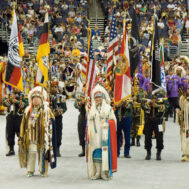Earlier this month, the Metropolitan Museum of Art in New York announced that Charles and Valerie Diker have made a gift of 91 masterworks to the museum from their collection of Native American art. The objects will be exhibited in the American Wing of the Met, starting in the fall of 2018 – the first time that the Met has placed an extensive collection of Native American objects “within their geographical context.” Past exhibitions of Native American objects have primarily been displayed ethnographically at the Met, within the Arts of Africa, Oceania and the Americas galleries.
In most museums, the creative works of indigenous peoples are rarely brought into the main galleries or granted the prestige of ‘works of art.’ Such items are most often displayed in an ‘ethnographic’ context, or in separate galleries dedicated to ‘decorative art’ or ‘craft’, depending upon the medium of the works. (It must be also said that some Native peoples object to calling objects ‘artworks’ if they are traditional creations or have meaning as ceremonial objects.) At least in the museum world, having a place in the main galleries is a form of recognition, signaling acceptance into the pantheon of the art world.
Charles and Valerie Diker are experienced collectors, well-versed in Contemporary and Modern art, and knowledgeable about the aesthetics of color, shape and design. The Dikers began their relationship with Native American art on a visit to Taos, New Mexico over 40 years ago, when an intriguing American Indian basket caught their attention. Over the years, the Dikers’ Native American collection expanded beyond the Southwest to encompass all of North America, with artistic representation from many tribes and pueblos, and including works from the pre-Contact era to the 20th century. The Diker collection is often considered to be the most comprehensive and refined of any private collection of its kind.
The Dikers have been involved with The Met since the 1990s, as donors and lenders from their collections. They have given over 20 items to the permanent collection and shown their Native American artworks in multiple exhibitions beginning with Native Paths: American Indian Art from the Collection of Charles and Valerie Diker from 1998-2000.
It is not known how the Met will curate and display the collection in the American Wing. However, it is sure to reflect the perspective of the collectors. In a recent interview with New York Times reporter Randy Kennedy, Mr. Diker expressed his appreciation of the future placement of the collection, “We always felt that what we were collecting was American art, and we always felt very strongly that it should be shown in that context.”
Last year’s touring exhibit, Indigenous Beauty: Masterworks of American Indian Art from the Diker Collection, also reflected this element of the Dikers’ vision, emphasizing the artistry and aesthetic qualities of the individual works, rather than focusing on historical and cultural context.
The recent show at the Met, Native American Masterpieces from the Charles and Valerie Diker Collection (October 28, 2016-March 31, 2017), followed a similar vision as Indigenous Beauty, although it was not connected with American Wing. The exhibit stood alone, showcasing the artistry of its Native American creators.
This is the first time that an artistic dialogue will take place on such a large scale between the masterworks of the Diker collection – or any collection of Native American works – and the American Wing of the Met.
There may be a hint of what is to come in the pairings of previous gifts from the Diker Collection and non-Native works in the American Wing of the Met:
A geometrically woven Pomo basket from California sits on a stand to the left of Jules Tavernier’s “Dance in a Subterranean Roundhouse at Clear Lake, California,” bringing an object from the same tribe and time period as depicted in the painting together into the viewer’s vision, allowing a deeper connection to the scene.
A starkly black ceramic olla by Tewa potters Maria and Julian Martinez from Po-Woh-Geh-Owingeh (San Ildefonso Pueblo) New Mexico invokes a relationship – of nature and form – with the black mesa central to Ernest Blumenschein’s painting “Taos Valley, New Mexico,” a site just 75 miles away.
The relationship between art and history in the American Wing of the Met was reinvented with the Wing’s makeover in 2012 and may have paved the way for the integration of the Diker Collection.
More than aesthetics may be considered when integrating Native American objects within the American Wing of the Met. There are layers of artistic, historical and cultural perspectives inherent to each object.
For example, the Met’s press releases included images of a dynamic painted shield gifted by the Dikers, made by the Hunkpapa Lakota master Joseph No Two Horns, of Standing Rock, in the 1880s. Given the recent controversy surrounding the sale of an Acoma Pueblo shield in Paris, which is considered a ceremonial object for that tribe and is not supposed to be photographed, much less displayed, is there a conflict, or a misappropriation here? No. The shields are similar in construction, and the Lakota shield has a bird image that has spiritual significance, but the Lakota shield was not made for ceremonial purposes and is appropriate for exhibition.*
The Met stated in its press release that “the Dikers have been ardent and generous supporters of a broad range of cultural institutions across the visual and performing arts.” Most notably, in the context of their collection of Native American Art and donation to The Met, Mr. and Mrs. Diker have served as the Founding Chairman and Chairwoman of the Smithsonian’s National Museum of the American Indian, George Gustav Heye Center in New York.
The Met also reports that Mr. Diker “is a member of the board of trustees of the Solomon R. Guggenheim Foundation and New York Public Radio. He has previously served on the Board of Trustees of the Brooklyn Academy of Music and the Santa Fe Opera Foundation, as President of the American Friends of the Israel Museum, and as a member of the Visiting Committee of the Harvard University Art Museums. Mrs. Diker is Founding Chair of the National Dance Institute New Mexico and a member of its national board, and has served as Chairman of Twyla Tharp Dance. In addition to their collection of Native American art, the Dikers collect modern and contemporary art. Mr. Diker is the founder and Chairman of the Board of Cantel Medical Corp.”
The Dikers’ generous gift has given the Met a unique opportunity to bring an understanding of history and to reflect on the varieties of artistic expression and the significance of cultural context together in this new and important element of the American Wing.
*The similarities between the two shields aptly illustrate the extraordinary potential for confusion and prosecutorial abuse inherent in the proposed STOP Act. See Two Dangerous Bills Fail: STOP and TAAR Die in Committee.
 Dance mask, ca. 1916–18. Hooper Bay, Alaska, Collection of Charles and Valerie Diker (788) © Charles and Valerie Diker Collection.
Dance mask, ca. 1916–18. Hooper Bay, Alaska, Collection of Charles and Valerie Diker (788) © Charles and Valerie Diker Collection. 

